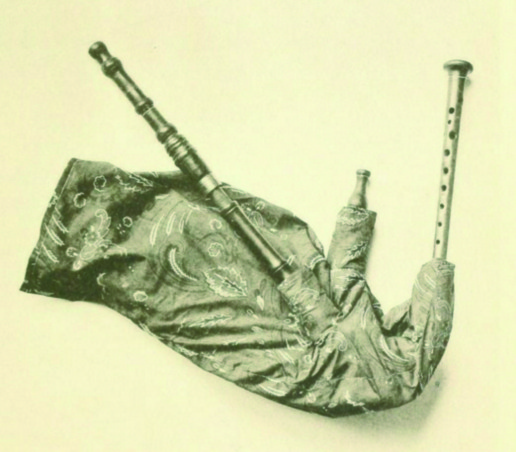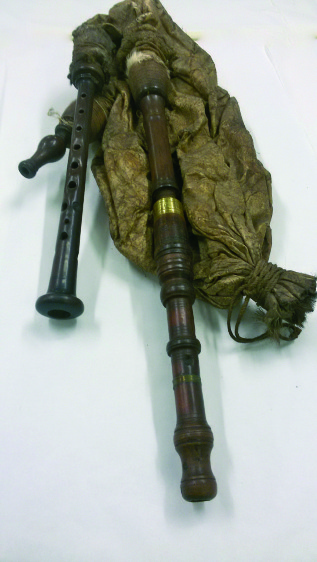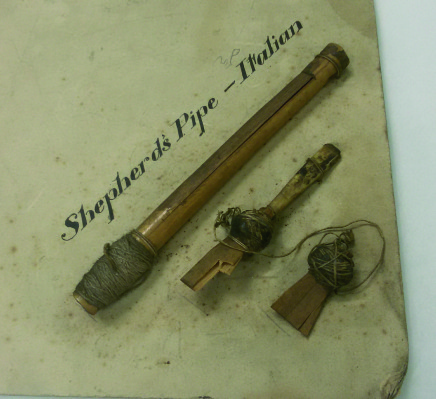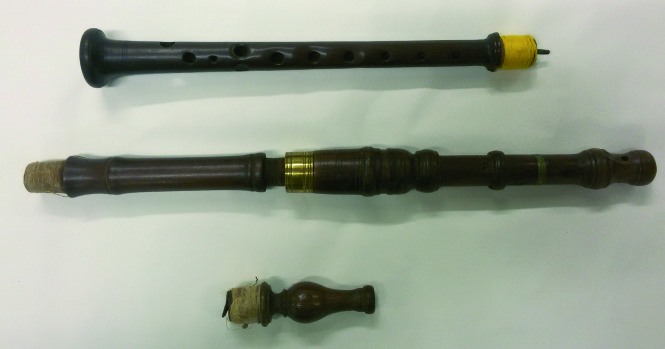The Bagpipe Society
The Edinburgh Müsa
The müsa is a small bagpipe with a single drone, typical of the valleys branching out from the heights of Appennino, approximately around the top of Mt Chiappo (1700mt. high) in the North of Italy. This small area is divided between the provinces of Pavia, Genoa, Alessandria and Piacenza and known locally as the “region of the Four Provinces” This area has a wide repertoire of traditional music, dances and songs, handed down by word of mouth and played on the piffero, a loud shawn typical of the area. The piffero was accompanied by the müsa until a hundred years ago, when its role was taken over by the accordion.

Over the last 15 years I have measured many old instruments in both museums and private collections, but it is the Museo Guatelli in Ozzano Taro that has the most remarkable collection. All the original müsa are in Italy except the one that is the National Museum in Edinburgh. In April 2015 I had the chance to go to Scotland and examine it, together with pipemaker Julian Goodacre (a special thank you to him for his help).
This instrument has been known for a long time because it is mentioned in a book written in 1907 by Alexander Duncan Fraser, an amateur and collector of bagpipes who owned a number of instruments. Fraser died in 1920 and later its family donated his collection to the museum in 1947. You can still see the catalogue number 1947-117, signed with white paint, on the müsa chanter. It is a very interesting instrument; first of all because it is complete, with reeds, bag, and a red lining cover.i Nowadays we know of only one other complete müsa.ii Furthermore, it is very old, being at least a hundred years old - but it is, very probably, much older. Lastly, it seems to have been played a lot as it shows clear signs of use and therefore it is possible that we could gain much from its analysis and eventual reconstruction.
For the first part of this article I will describe the müsa in general, coming to the detailed description of the Edinburgh specimen in the second part (to be published in the next issue).
Julian Goodacre, bagpipe maker in Peebles, examined the Edinburgh müsa yet in 1985. At that time Maurizio Martinotti of the band “La Ciapa Rusa” (an important group in the folk music revival from Piedmont) ordered a copy of it. The copy made by Julian has been used by members of the band and it is still in his possession in Casale Monferrato. Julian wrote an article about the müsa on a previous issue of Chanter (see bibliography).
There is a short biography of A.D. Fraser on the museum website: Dr Alexander Duncan Fraser MD (1849-1920), born in Lochgilphead of an Inverness-shire family, graduated in medicine from Edinburgh University in 1874 and subsequently practised in Northumberland, Skye and Falkirk. His lifelong hobby was playing the pipes, studying the history of the bagpipe and its music, and collecting ancient and modern bagpipes ‘of all nations’. In 1906 (author’s quote: in fact in 1907) he published a book, Some Reminiscences and the Bagpipe, in which many of the instruments in his collection were illustrated. Some of his collection was donated to the Royal Scottish Museum in 1947. His collection forms an important part of the piping collection of the National Museums of Scotland and of the displays in the Museum of Piping. (The book, referred in bibliography as FRASER 1907 has been reprinted as a modern edition and it is also freely available online: https://archive.org/details/somereminiscence00fras)

The book deals with bagpipes in general, focusing on Great Highland Bagpipe from a historic point of view; one chapter, titled THE ROMANS AND THE BAGPIPE is dedicated to the instrument we talk about. Without question, the opinions of the author are quite weird! The tagline under the müsa image at page 232 says:
THE CELTIC PIVA OR BAGPIPE OF NORTHERN ITALY The ancient Tibia Utricularis of the Romans, a very old pipe, as the worn fingerholes of the hard walnut chanter show
Fraser’s aim is to track the origin of the bagpipe down to the era of ancient Romans and Greeks…the author’s theory is that the Romans discovered the bagpipe from the Celts (the ones from Pannonia in particular, according to some Roman author that however isn’t cited) and that the term PIVA for the instrument and PIFFERARI for the player come from a Celtic root, the same of the modern terms PIPE in English, PIOB in Gaelic, PIBE in welsh. This is further confirmation that people wanting to finding Celtic origins in things that have nothing to do with it are not exclusive of our time!

First of all, Fraser was clearly unaware that the instrument is a müsa and not a piva. I’d like to shed some light on this matter. The word PIVA is well documented in Italy since the middle ages and it still means a bagpipe today and it is a popular instrument, especially in the north of Italy.
More specifically, it is used to define the bagpipe typical of the hills surrounding Parma and Piacenza, in Emilia,iii and in the Bergamo area where the dialect term “pia” was mainly used instead of “baghèt” that is more common today. The same word was sometimes used to mean the chanter, or even the chanter double reed, called “pia” or “pi-ì” (BIELLA 2000, p.13-15). The word “piva” evokes a pipe that “peeps on the drones”. It is onomatopoeic, from Latin root “pipire” – to mean the peeping of the birds – in turn coming from “pipa” that means: toys, primitive musical instruments such as flutes, vibrating leaves and flower stems, hunter’s birdcalls (“pivetta” in Italian) and everything that produces shrilling sounds. The history of this root-word is the reason of its wide diffusion in Europe. (GRULLI 2016)
Moreover, Fraser uses the wrong term for the player: PIFFERARI is an archaic form (modern pifferai), it is plural (singular is pifferaro, modern pifferaio) and with any evidence tells the piffero and not the bagpipe player.
The PIFFERO is the instrument traditionally played with the müsa. This word has been in use since the Middle Ages and can generically refer to any double reed instrument, like a shawm, normally of smaller size. This term is still in common use today, although it is more likely to refer to a small transverse flute, like the piccolo or fife (e.g. the pifferi of the carnival of Ivrea in Piedmont).
To add even more confusion, on p. 208 of the same book there’s a photograph titled ITALIAN PIFFERARI but the players are two zampognari from the South of Italy, nothing to do with the piffero we’re talking about.
Anyway, it would be really interesting for us to know how the müsa travelled all the way to Scotland; Fraser gives us a little help telling that it is a donation from Mr. Sutherland of Solsgirth, Dollar (a town north of Edinburgh) but it still does not say how it arrived there from Italy.
I searched for similarities between the Edinburgh müsa and the other historical examples, finding that all of them are pretty much different. The exception was one found in Montoggio near Genoa by Claudio Cacco in the late 1990s; it belonged to Angelo Vaggè Langin (1849-1936) and was stored by his descendants: could it have come from the same maker’s workshop? I will focus on this question in the second part of the article.iv
Besides Fraser’s, we have another mention of the Edinburgh müsa in the well-known book Bagpipes from Anthony Baines:
The rare, if not now extinct, shepherd’s bagpipe of sub-Alpine Italy, piva, is illustrated by an instrument in the Fraser collection. It has a whole skin bag, with a printed cloth cover open at the bottom. Blowpipe and drone are in the forelegs, chanter in the neck. The pipes are turned in walnut. The well-worn conical chanter, length 31 cm. has hole 7 (no thumbhole), with hole II duplicated (L. hole plugged), two side vents and a front vent above them, and a slightly flared lower end with 1.9-cm. opening. The cane reed closely resembles that of the old Spanish gaita in the same collection, with a very short staple waxed firmly into the chanter. Preserved with the instrument is a bone mandrel for making spare reeds off the staple […] The bass drone is two-jointed, totalling 40 cm., with a rough 0.9-cm. bore in the first joint and 1.3-1.4 cm. in the second, which is plain-ended without a cavity. The drone reed is a single cane reed. The piva is occasionally shown in old pictures, e.g. a sixteenth-century pastoral engraving by Benedetto Montagna.v BAINES 1960, p. 109
Overlooking the confusion of terms (again piva instead of müsa), it is evident that Baines had the opportunity to personally examine the instrument, due to the precision of the reported dimensions. But both Fraser and Baines ignored the piffero in the specific sense that the instrument traditionally played with the müsa, and this is strange, because piffero playing was still a living tradition in their times - as it is today - even if only locally, while on the other hand the piva they often mention was already almost extinct.
The origins of the müsa are lost in the mists of time. The earliest reference comes from Liguria of the 16th century. The oldest documents known both date from 1578: a writing by Giuseppe Pessagno reporting events which happened in Otero names a “fifaro”; and a bishop’s edict against traditional celebrations for the feast of S.Anna (July 23rd) in Sestri Levante; “dances around the church dedicated to the Saint and in other places of the town and boundaries under the mayor’s jurisdiction, with the playing of Muse, and other instruments, and strictly forbid to play Muse, Lutes, Harps, Lyres, Rebecs, Citterns, Guitars, Flutes, Piffali, Cornets:vi nor any other sort of instruments for dance music […] and dancing Riondevii in any place, under the same penalties”. In the same way it was forbidden that the Brotherhood of Santa Caterina del Borgo, to play Muse or any other sort of instruments GNOLI-PAVETO et al. 2007, p. 163.
More references to the müsa are in a document from 1583 (where it is called musetta)viii regarding facts happened in the Fontanabuona valley, and in other historical reports: of 1593, in Torriglia, in 1661 in Marzano near Torriglia, and in 1750 again in Torriglia. (all reported in the a/m book at p. 163)
The 1578 document is very interesting because it also mentions the piffero and many other instruments; furthermore we should notice that all these documents come from an area in the outback of Liguria. As of today, the making of the müsa prior to the 20th century is still shrouded in mystery, but we probably have to take a closer look at this region in order to discover more: first of all it is the homeland of Nicolò Bacigalupo “u Grixu”ix (1863-1937) the last of the old makers and the only one whose work is well documented. Other makers haven’t been identified but all the clues suggest a wide spread of these instruments in the past times on the Ligurian side, much stronger than today’s where the piffero and müsa have almost disappeared.
One impressive peculiarity of the piffero-müsa is that the two instruments don’t play in the same key: the piffero is in G while the müsa chanter plays a C scale, on a G drone. This means that they couldn’t just play the same melody like other shawn-bagpipe couples (e.g. in Brittany), but played a kind of polyphony. Unfortunately, we don’t have any recording of the old players, and the way they used the müsa to accompany is entrusted to mere supposition.

Prior to the 20th century, the pitch of the two instruments was slightly lower than modern A=440hz, by almost half a tone, but as soon as they started being played with accordions, the piffero players started using higher pitched instruments. Jacmòn (Giacomo Sala, 1873-1962) who is probably the most influential piffero player of all time,x is responsible for this choice, having sensed that the bagpipe was falling out of fashion: after the transition he even adapted the piffero to a new repertoire of couple dances like the waltz, polka or mazurka.xi He worked in partnership with the maker Nicolò Bacigalupo “u Grixu”, whose workshop was in Cicagna, to make a new generation of pifferi suitable for playing with accordions. Bacigalupo’s instruments were highly regarded in his time and sought by all the best players, and many of them survived.
Because of the raising of the pitch, the earliest pifferi are a bit longer than the new ones, likewise the müsa: the Edinburgh chanter belongs to the old low-pitched family, with its 318mm length, while the Grixu chanters are normally under 300mm.
Sadly, many pifferi from the pre-accordion era show poor attempts to retune them up, often in very rough ways such as cutting them down with hacksaws and roughly enlarging the holes. The fact that the müsa disappeared from musical use right at that time actually saved many old instruments from being spoiled in such a detestable way.
The tradition of playing the piffero and müsa together was still alive at the beginning of the 20th century, but it suddenly died out. By 1940s the müsa had been replaced by the accordion. The last müsa players were Giovanni Raffo “Creidöra” (1844-1918), Carlo Buscaglia “Pillo” (1861 or ‘62-1935), Carlo Musso named “Pragaja” or “Carlaja” (1873-1956). We still have the instruments that belonged to these players: the chanter of the Pillo müsa is preserved by his descendants,xii and the Pragaja one (wooden parts only with no bag) was hold by Febo Guizzi, an ethnomusicologist who recently died. The müsa of Pragaja is the same that was previously owned by his mentor Creidöra.xiii
BIBLIOGRAPHY
AAVV 2004: M. Balma – C. Bonnafous – P. Ferrari – L. Messori – A. Zanocco, Giacomo Jacmòn Sala, Nota cd book 519, Udine 2004
BAINES 1960: Anthony Baines, Bagpipes, Pitt Rivers Museum, Oxford 1960
BIELLA 2000: Valter Biella**, Il baghèt la cornamusa bergamasca**, Meridiana, Bergamo 2000
BIELLA – GANDOLFI 2012: Valter Biella e Riccardo Gandolfi, I pifferi di Calvari – note tecniche e organologiche, self-printed book, Bergamo 2012
FRASER 1907: Alexander Duncan Fraser, Some reminiscences and the bagpipe, W.J.Hay, Edinburgh 1907
GNOLI-PAVETO et al. 2007: Claudio Gnoli and Fabio Paveto, “U messié Draghín”, in Paolo Ferrari et al., Chi nasce mulo bisogna che tira calci, Associazione Musa, Cosola 2007
GOODACRE 2014: Julian Goodacre, MüSings On The MüSa, in Chanter, periodic issue of The Bagpipe Society, ed. Summer 2014, Leek, Staffordshire, p. 25-30
GRULLI 2016: Bruno Grulli, Aspetti vari della Piva Emiliana, unpublished article, 2016
THANKS TO:
Enrico Barchetta, Matteo Burrone, Claudio Cacco, Ferdinando Gatti, Julian Goodacre, Bruno Grulli, Stephen Jackson, Renato Lagomarsino, Stefano Valla.
Some of the photographs were taken by Julian Goodacre.
NOTES:
i I’m told by the Curator that the müsa had a spare bag cover, at the moment on display in Glasgow wrongly associated with a zampogna from the same collection. I didn’t have the chance to check out this statement but a zampogna surely was in Fraser’s possession (see p. 216 of his book). Anyway the müsa, even if property of the museum for nearly 70 years now, has never been shown to the public, because the Edinburgh Museum has just a small collection of musical instruments and they never fit out a dedicated section. So, some of their instruments were sent to Glasgow for display. Not the müsa, that today is still lying in the deposit.
ii The other complete müsa is in a private collection near Torino. See: Valter Biella, La Müsa delle “Quattro Province”, in UTRICULUS periodic issue of the Associazione Culturale “Circolo della Zampogna”, anno XIII numero 48, Scapoli 2014, pag. 29-42.
iii A brief article by Jane Moulder about the Piva from Emilia appeared in the Spring 2014 edition of Chanter at p. 26-28
iv A plan made by Valter Biella of the Langin müsa is available online: http://bit.ly/Chanter7
v Benedetto Cincani aka “il Montagna” (c. 1480 – 1558) was a painter and engraver from
Vicenza. Baines refers to this xylograph: http://bit.ly/Chanter6
vi In the original italian: Muse, Liuti, Arpe, Viole, Lire, Rebecchini, Cittere, Chitarre, Flauti, Piffali, Cornetti
vii Rionda, a word meaning “round” in ligurian language, to evoke the old circle dances.
viii Musetta is a diminutive, literally “a small müsa”.
ix Grixu means “grey” in ligurian.
x Jacmòn is the first piffero player that has been recorded, down in 1958. The book AAVV 2004 in bibliography contains a cd with the remastered recording.
xi In old times the piffero repertoire was entirely made of local group dances like Alessandrina, Monferrina, Giga, Piana. In today’s practice we have a 70-80% of couple dances and a 20-30% of surviving old ones.
xii In Cegni, Pillo’s native town, besides the chanter that we know for sure was part of his müsa, two drone segments have been found. They were donated to Stefano Valla by a local man; there are fair chances that one of them (or both) belonged to the instrument of Pillo. Unfortunately we don’t have any proof about that; they even do not make up a complete drone: both are the end part with the first section missing. Furthermore, they are turned in two slightly different qualities of timber.
xiii In the area is it common to call the people with a nickname, that often is simply the town of origin of the person, in the local dialect: so Creidöra is “the one from Caldirola”, Pragaja is “from Pradaglia”, Brigiottu (another famous player) is “from Bruggi”, etc
- Data Processing Notice (GDPR)
-
@BagpipeSociety on X (formally known as Twitter)
-
TheBagpipeSociety on Instagram
-
 BagpipeSociety on Facebook
BagpipeSociety on Facebook
Something wrong or missing from this page? Let us know!
